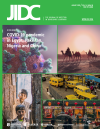Comparison of clinical characteristics between fecal/perianal swab nucleic acid-positive and -negative patients with COVID-19
DOI:
https://doi.org/10.3855/jidc.12885Keywords:
COVID-19, SARS-CoV-2, clinical characteristics, fecal swab, ACE2, PCRAbstract
Introduction: We analyzed the clinical characteristics of COVID-19 fecal/perianal swab nucleic acid-positive patients in our hospital and evaluated the effect of SARS-CoV-2 on the gastrointestinal tract.
Methodology: Ninety-seven patients in the Fifth Affiliated Hospital of Sun Yat-sen University from January 17, 2020 to March 2, 2020 with fecal/perianal swab samples were selected as subjects and the results of real-time fluorescence reverse transcriptase-PCR SARS-CoV-2 nucleic acid detection of fecal/perianal swabs were used to divide subjects into positive and negative groups.
Results: Fecal/perianal swabs of 53.61% (52/97) patients were positive including 31 males (59.62%) and 21 females (40.38%). The negative group had more females than males (P = 0.001). The distribution of case classification based on the most severe condition observed after admission was different between groups: five (5.15%) critical type patients were all from the positive group (P = 0.029). There was no statistical difference in clinical manifestations between the groups. In the positive group, the mean nucleic acid-negative conversion time was 14.13 ± 8.61 days, which was significantly later than the negative group (6.98 ± 5.16 days; P < 0.001). In the positive group, 92% (48/52) had nucleic acid-negative conversion with a mean nucleic acid-negative conversion time of 22.58 ± 10.30 days. Among them, 41 (78.85%) cases were delayed compared with pharynx/nasal swab nucleic acid-negative conversion time.
Conclusions: The positive rate of fecal/perianal swab nucleic acid in male patients was higher than that in female patients. Fecal/perianal swab nucleic acid positive may be an indicator of critical conditions in those with COVID-19.
Downloads
Published
How to Cite
Issue
Section
License
Authors who publish with this journal agree to the following terms:
- Authors retain copyright and grant the journal right of first publication with the work simultaneously licensed under a Creative Commons Attribution License that allows others to share the work with an acknowledgement of the work's authorship and initial publication in this journal.
- Authors are able to enter into separate, additional contractual arrangements for the non-exclusive distribution of the journal's published version of the work (e.g., post it to an institutional repository or publish it in a book), with an acknowledgement of its initial publication in this journal.
- Authors are permitted and encouraged to post their work online (e.g., in institutional repositories or on their website) prior to and during the submission process, as it can lead to productive exchanges, as well as earlier and greater citation of published work (See The Effect of Open Access).








